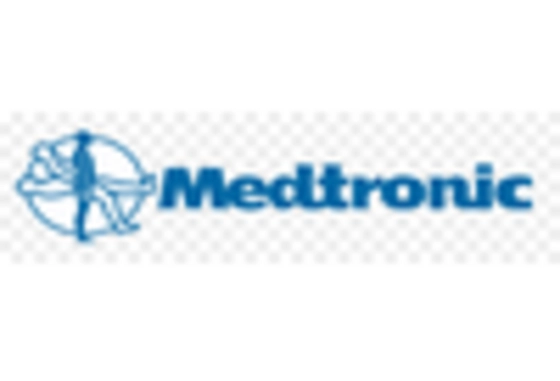The Pneumatic Tourniquet Market is characterized by a dynamic competitive landscape, driven by technological advancements and an increasing demand for surgical efficiency. Key players such as Zimmer Biomet (US), Stryker (US), and Medtronic (IE) are at the forefront, each adopting distinct strategies to enhance their market presence. Zimmer Biomet (US) focuses on innovation in product design, particularly in developing user-friendly pneumatic systems that improve surgical outcomes. Stryker (US), on the other hand, emphasizes strategic partnerships and acquisitions to bolster its product portfolio, while Medtronic (IE) is heavily investing in digital transformation to integrate smart technologies into its tourniquet systems. Collectively, these strategies not only enhance operational capabilities but also intensify competition within the market, as companies strive to differentiate themselves through advanced technology and superior service offerings.
In terms of business tactics, companies are increasingly localizing manufacturing to reduce lead times and optimize supply chains. This approach appears to be a response to the growing demand for rapid delivery and customization in surgical settings. The market structure is moderately fragmented, with several players vying for market share, yet the influence of major companies like Boston Scientific (US) and Smith & Nephew (GB) remains substantial. Their ability to leverage economies of scale and invest in research and development positions them as formidable competitors, shaping the overall market dynamics.
In August 2025, Stryker (US) announced the acquisition of a leading software company specializing in surgical data analytics. This strategic move is likely to enhance Stryker's capabilities in integrating data-driven insights into its pneumatic tourniquet systems, thereby improving surgical precision and patient outcomes. The acquisition underscores Stryker's commitment to innovation and its recognition of the growing importance of data in surgical environments.
In September 2025, Medtronic (IE) launched a new line of pneumatic tourniquets equipped with AI-driven features that allow for real-time monitoring of limb occlusion pressures. This development is indicative of Medtronic's focus on integrating advanced technologies into its products, which may significantly enhance the safety and efficacy of surgical procedures. The introduction of AI capabilities could potentially set a new standard in the market, compelling competitors to accelerate their own technological advancements.
In October 2025, Smith & Nephew (GB) unveiled a sustainability initiative aimed at reducing the environmental impact of its pneumatic tourniquet production. This initiative includes the use of recyclable materials and energy-efficient manufacturing processes. Such a move not only aligns with global sustainability trends but also positions Smith & Nephew as a responsible leader in the market, appealing to environmentally conscious healthcare providers.
As of October 2025, the competitive trends in the Pneumatic Tourniquet Market are increasingly defined by digitalization, sustainability, and the integration of artificial intelligence. Strategic alliances are becoming more prevalent, as companies recognize the value of collaboration in enhancing innovation and market reach. Looking ahead, it is anticipated that competitive differentiation will evolve from traditional price-based strategies to a focus on technological innovation, reliability in supply chains, and sustainable practices, thereby reshaping the competitive landscape in the years to come.

















Leave a Comment